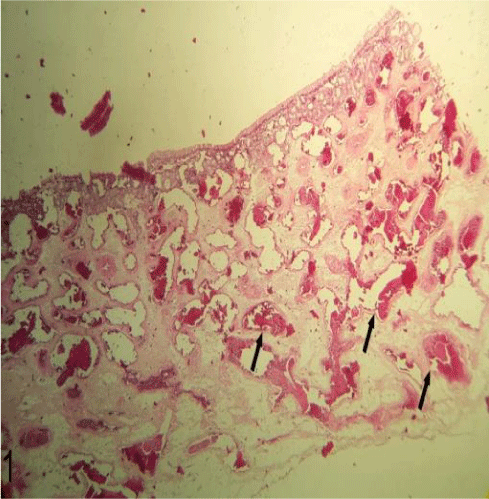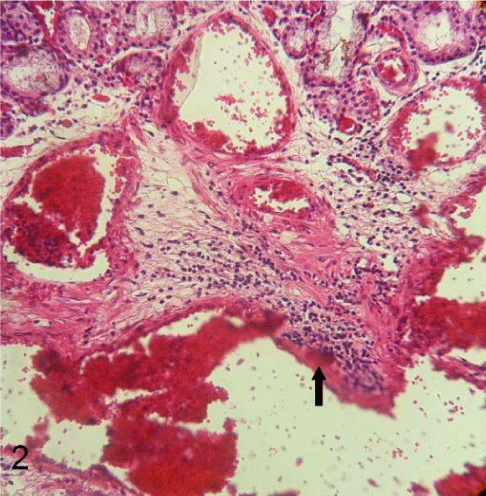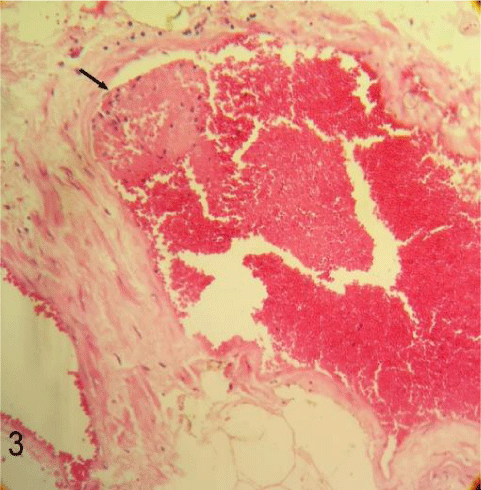International Journal of Veterinary Science and Research
Nasotracheal Cavernous Hemangioma in Sheep (Case Report)
Farhang Sasani1*, Farhad Moosakhani2, Mohsen Zafari3, Diba Golchin1 and Zahra Moradi1
2Department of Microbiology, Faculty of Veterinary Medicine, Islamic Azad University, Karaj Branch, Karaj, Iran
3Private Veterinarian, Mabna Veterinary Diagnostic Reference Laboratory, Karaj, Iran
Cite this as
Sasani F, Moosakhani F, Zafari M, Golchin D, Moradi Z (2015) Nasotracheal Cavernous Hemangioma in Sheep (Case Report). Int J Vet Sci Res 1(1): 001-002. DOI: 10.17352/ijvsr.000001A two-year-old ewe was presented to Veterinary Hospital, with a sudden onset of diarrhea, epistaxis, reluctance to move and recumbency which eventually led to its death. After necropsy and tissue sample collection for further examinations, histopathological study revealed large submucosal vascular structures with some thrombotic and blood filled spaces indicator of nasotracheal cavernous hemangioma, diffuse lymphocytic enteritis, hepatic diffuse mild vacuolar degeneration, severe pulmonary hyperemia and edema, cardiac and skeletal muscle sarcocystosis with severe hyperemia and fragmentation of cardiac muscle fibers, mild perineuronal edema of the spinal cord, hyperemia and perineuronal (Purkinje cell) edema in the cerebellum, hyperemia with perineuronal and perivascular edema in the cerebrum, severe hyperemia with diffuse severe acute tubular necrosis, and mild intratubular and intrabowman’s capsular space proteinaceous material in the kidney. To the authors’ knowledge, this is the first case report of Nasotracheal hemangioma in sheep in Iran.
Introduction
Hemangiomas are detected in the skin, spleen, oral cavity, muscle and bladder, as benign tumors of vascular endothelium which are commonly seen in dogs, less commonly in cats [1,2], and rarely in other domestic animals, as they may occur in very young horses and swine [1,3,4]. Macroscopically hemangiomas are well-demarcated, encapsulated masses, ranging from blue, bright red to dark brown. In large specimens the cut surface has a honeycomb pattern of fibrous trabeculae separating blood-filled cavities. Histologically, most hemangiomas are well circumscribed, and are composed of vascular spaces of variable size, with the properties of normal vascular endothelium. Organized thrombi with foci of hemosiderosis are common histopathological findings in this tumor. Based on the size of the vascular channels two variants of these tumors are known; as cavernous or capillary hemangiomas. In the cavernous type, which is more common in dogs, the large channels are separated by fibrous connective tissue stroma which may contain inflammatory cells such as lymphocytes, mast cells and hemosiderin-laden macrophages. In the capillary variant there is little stroma, a more cellular appearance and large, sometimes pleomorphic, nuclei compared to the cavernous variant [3,4].
Hemangiomas have been recorded in cattle (adult and aged), horses (less than 1 year of age), sheep, swine and fowls, but it is only in cats and dogs (both mean age of approximately 10 years) that frequency of occurrence has been estimated, therefore, according to the references, highest incidence of hemangiomas is reported in dogs and cats (without apparent sex, breed or site predilection) as described above [2,4,5].
A round-shaped, pedunculated, soft and dark red mass on gingival compartment of midlateral edge of mandibular region of a five-year-old Iranian cross breed ewe has been reported [5]. Also a case of verrucous hemangioma has been addressed in an eight-year-old horse on its pastern [6]. A case of a 15-year-old gelding presented with progressive lameness of the left forelimb of 2.5 months duration, a dilation of the deep flexor tendon sheath with a firm elastic consistency and a pronounced tenderness was noted and diagnosed as synovial hemangioma on the basis of the histopathological, immunohistochemical and ultrastructural features [7]. A case of concurrent intranasal hemangioma and tetracycline induced gastritis and ulceration in a dog has been reported [8].
Case Presentation
We present a case of nasotracheal cavernous hemangioma in an Arabi sheep, which was part of a flock of 140 sheep and 23 goats, located in Damavand, the capital of Damavand County, Tehran Province. On 7 Feb 2015, a two-year-old ewe was presented to veterinary hospital with a sudden onset of diarrhea, epistaxis, and reluctance to move and recumbence which eventually led to its death. Necropsy and sample collection were undertaken for further examinations. Tissue samples were obtained from nasotrachea, kidney, heart, cerebrum, cerebellum, spinal cord, skeletal muscle, lung, liver and small intestine. All specimens were fixed in 10% neutral buffered formalin, embedded in paraffin, sectioned to a thickness of 4 μm, and stained with hematoxylin and eosin. Histopathological findings are summarized in Table 1, Figures 1-3.
Discussion
Intranasal tumors in dogs are extremely rare, less than 1% of all cancers, but the malignant types of intranasal vascular tumors have a little higher incidence. Approximately two-thirds of canine intranasal tumors are carcinomas and the remaining third is comprised of sarcomas [8,9]. Hemangioma and hemangiosarcoma are associated with blood clotting affects with decreased platelet count and increased blood clotting time [8]. There are few reports of this tumor in sheep. Only a round-shaped, pedunculated, soft and dark red mass on gingival compartment of midlateral edge of mandibular region of a five-year-old Iranian cross breed ewe has been reported [5]. According to the references, highest incidence of hemangiomas is reported in dogs and cats (without apparent sex, breed or site predilection) [2,4]. Although this tumor is considered as a benign tumor, mitotic figures are rarely seen. The tumor is generally slow growing.
This unusual presented nasotracheal submucosal hemangioma is believed to be very rare with only a few reports.
The authors would like to thank Mabna Veterinary Diagnostic Reference Laboratory, and Mr. Golchinfar for histopathological technique.
- Aita N, Iso H, Uchida K (2010) Hemangioma of the Ileum in a Dog. J Vet Med Sci 72: 1071–1073.
- Miller MA, Ramos JA, Kreeger JM (1992) Cutaneous Vascular Neoplasia in 15 Cats: Clinical, Morphologic, and Immunohistochemical Studies. Vet Pathol 29: 329-336.
- Donald J. Meuten (2008) Tumors in Domestic Animals. Fourth Edition. Iowa State Press, Ames, Iowa, USA 99.
- Jubb KVF, Kennedy PC, Palmer N (2007) Pathology of Domestic Animals; Saunders, Elsevier 1: 767.
- Mohajeri D, Mousavi Gh, Rezaie A (2008) Gingival Hemangioma in a Sheep. Iranian Journal of Veterinary Surgery 3: 85-89 .
- Pérez-Écija A, Estepa JC, Barranco I, Rodríguez-Gómez IM, Mendoza FJ, et al. (2004) Verrucous hemangioma with pseudoepitheliomatous epidermal hyperplasia in an adult horse. Vet Pathol. Sep 51: 992-995 .
- Holzhausen L, Nowak M, Junginger J, Puff C (2012) Synovial hemangioma in an adult horse. J J Vet Diagn Invest 24: 427-430 .
- Banga HS, Deshmukh S, Brar RS, Gadhave PD, Chavhan SG, et al. (2010) A Case of Intranasal Hemangioma and Concurrent Tetracycline-induced Ulcerative Gastritis in Dogs. Toxicol Int 17: 33–36 .
- Sones E, Smith A, Schleis S, Brawner W, Almond G, et al. (2013) Survival times for canine intranasal sarcomas treated with radiation therapy: 86 cases (1996-2011). Vet Radiol Ultrasound 54: 194-201 .
Article Alerts
Subscribe to our articles alerts and stay tuned.
 This work is licensed under a Creative Commons Attribution 4.0 International License.
This work is licensed under a Creative Commons Attribution 4.0 International License.




 Save to Mendeley
Save to Mendeley
